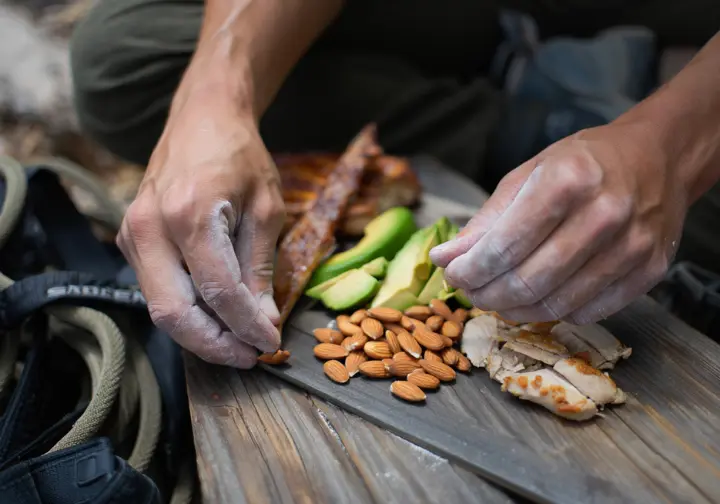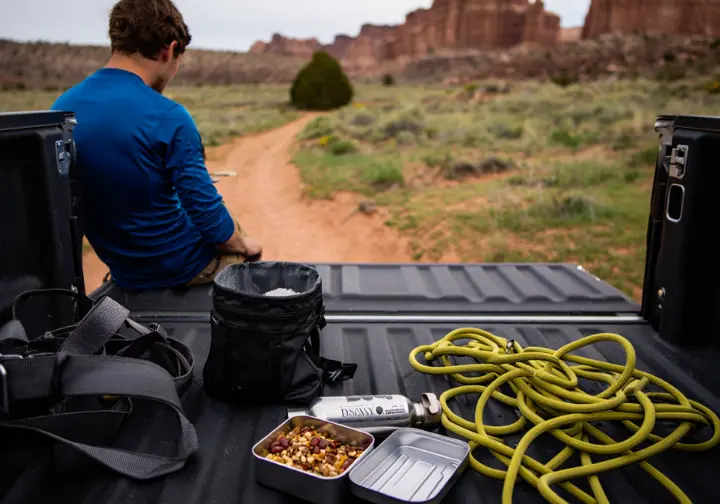In this article
Within the climbing community, the pursuit of an optimized strength-to-weight ratio is relentless, leading many to consider a low carb, keto, or carnivore diet. For every compelling story of a climber feeling lighter and stronger, however, stark warnings from sports scientists caution against compromised power and blunted training adaptations. This creates a confusing landscape of conflicting information. This guide cuts through the noise, providing a definitive, evidence-based analysis of these diets from the specific, physiologically demanding perspective of a climber. By establishing the science of how the body fuels movement, we can dissect how each diet interacts with those systems and deliver discipline-specific recommendations for boulderers, sport climbers, and trad climbers alike.
The Engine of Climbing – A Primer on Your Energy Systems

Before evaluating any diet plan, you must first understand the engine it is meant to fuel. The human body is powered by a sophisticated interplay of three distinct energy systems. This non-negotiable physiological framework is the standard against which all dietary strategies for athletes must be judged. For a climber, these are the gears of performance, each engaged depending on the intensity and duration of the effort.
First Gear: The Anaerobic Alactic (ATP-PC) System
The ATP-PC system is your engine for immediate, explosive power. It provides the energy for maximal-intensity efforts lasting from one to approximately twelve seconds. In climbing terms, this is the gear you engage for a single, desperate dyno, a powerful campus board move, or the viciously difficult crux of a short boulder problem. Its fuel is not the carbohydrates or fats you eat, but the small amount of Adenosine Triphosphate (ATP) already stored directly in your muscle cells.
This stored ATP is then rapidly regenerated by breaking down phosphocreatine (PCr). This system is incredibly powerful because it delivers energy almost instantaneously, but its fuel tank is exceptionally small and depletes quickly. Critically, the recovery of this system—the replenishment of phosphocreatine stores—is an aerobic process. This means your ability to recover between hard efforts and deliver repeated bursts of power is directly linked to the health of your overall aerobic system, a key factor in building foundational strength and power.
Second Gear: The Anaerobic Lactic (Glycolytic) System
When a high-intensity effort extends beyond the capacity of the ATP-PC system, your body shifts into its second gear: the Glycolytic system. This system is dominant for sustained high-intensity activities lasting from roughly 12 seconds up to two minutes. It is the power-endurance engine, absolutely critical for linking together the hard moves of a sport climbing crux sequence or pushing through the pump on a long, difficult boulder problem.
The most critical fact about this system for any athlete is that its fuel source is exclusively carbohydrates, which are stored in the muscles and liver as glycogen. Performance in this gear is therefore directly tied to your body’s glycogen availability, meaning your carbohydrate intake is paramount.
Through a process called glycolysis, glycogen is broken down without oxygen to rapidly produce ATP. A byproduct of this process is the accumulation of hydrogen ions (H+), which causes the muscle acidosis climbers experience as the dreaded “pump.” Lactate, far from being a simple waste product, is actually shuttled to other muscles and the liver to be used as an energy source, debunking a common myth in athletics.
Third Gear: The Aerobic System
For any effort lasting longer than about two minutes, and for all periods of rest and recovery, the body relies on its third gear: the Aerobic system. This is the long-duration, low-to-moderate intensity engine that powers a climber through the easier sections of a route, a long trad day, or an alpine approach. This system is fueled by both fats and carbs, which are broken down in the presence of oxygen to produce vast amounts of ATP.
While your body’s fat stores provide an enormous fuel tank, there is a crucial trade-off: liberating energy from fat requires significantly more oxygen than liberating it from carbohydrates. This makes carbohydrate a more efficient fuel source when oxygen delivery becomes a limiting factor during higher-intensity work. The aerobic system is also responsible for recovery; it replenishes the phosphocreatine stores used by “first gear” and helps clear the metabolic byproducts from the “second gear.” This allows you to recover between boulder attempts or at a rest stance on a route, making building a strong aerobic base essential. Scientific studies that have measured the energetic contributions during climbing confirm this mixed metabolic profile, underscoring the interplay between all three systems.
The Low-Carbohydrate Spectrum: From Carb-Restriction to Ketosis

The term “low-carb” represents a wide spectrum of dietary approaches, including Atkins diets and the more modern paleo diet. Understanding the key distinctions between a general low-carbohydrate diet and the specific metabolic state of ketosis is fundamental to evaluating their potential impact on a climber’s performance and health.
Defining “Low-Carb” vs. the Ketogenic Diet
A general low-carbohydrate diet restricts carbohydrate-rich foods relative to a typical diet, which often derives 45-65% of its calories from carbs. Low-carb diets vary, but often mean getting less than 26% of total energy from carbohydrates, with the primary goal of lowering insulin levels to encourage the body to burn stored fat. In contrast, the ketogenic diet is a very-low-carbohydrate, high-protein diet specifically formulated to shift the body’s primary fuel source from glucose to ketones.
This metabolic state, known as nutritional ketosis, is achieved through precise dietary restrictions: typically 55-75% fat, 20-35% protein, and a mere 5-10% carbohydrates, which often translates to less than 50 grams per day. This drastic carb reduction is necessary because the brain cannot use fat directly for energy. In the absence of glucose, the liver converts fatty acids into ketone bodies to provide an alternative fuel source. While there are potential benefits for improving glycemic control with these eating plans, the integration of the ketogenic diet with exercise presents unique challenges for athletes.
Inherent Risks and Common Side Effects of Keto
The restrictive nature of ketogenic diets is not without significant risks and side effects. During the initial adaptation phase, many people experience the “keto flu,” a collection of symptoms including headache, fatigue, and nausea, often linked to dehydration and electrolyte imbalances. Furthermore, severely limiting or eliminating fruits, starchy vegetables, and whole grains makes it difficult to obtain adequate fiber and increases the risk of deficiencies in essential micronutrients like vitamins A, C, and K, folate, magnesium, and potassium.
Long-term health implications are still debated, with concerns raised about the high intake of saturated fat potentially increasing LDL (“bad”) cholesterol and the long-term risk of heart disease. Researchers have documented its use in various health contexts, but for the general population, perhaps the most significant challenge is sustainability. The extreme dietary restrictions can be socially isolating and difficult to maintain, often leading to weight regain upon returning to previous unhealthy eating patterns. For athletes, navigating the world of very low-carbohydrate (VLC) diets requires careful consideration of these risks.
The Carnivore Diet: The All-Animal-Product Approach

At the most extreme end of the low-carbohydrate spectrum lies the carnivore diet. More than just a restrictive diet, it is often presented with a specific philosophical underpinning, positioning it as the biologically appropriate eating style for humans by eliminating all plant foods.
Definition, Philosophy, and Major Health Concerns
The carnivore diet is a zero-carbohydrate, animal-based nutrition plan. It involves consuming only meat, fish, poultry, eggs, and sometimes limited amounts of low-lactose dairy like butter and hard cheese. Functionally, it is a more restrictive version of a ketogenic diet, as the complete elimination of plants ensures carbohydrate intake is virtually zero, forcing the body into ketosis. Proponents argue that plant foods contain “anti-nutrients” and that eliminating them is key to reducing inflammation, a philosophy that should be viewed with extreme caution.
From a scientific standpoint, the carnivore is widely considered a fad diet due to its significant potential risks. The complete lack of dietary fiber is an immediate and serious concern, as fiber is essential for digestive health and feeding beneficial gut bacteria.
The diet cuts out entire food groups, creating a high risk of multiple nutrient deficiencies, particularly Vitamin C and folate, and lacks thousands of beneficial plant compounds. Finally, the diet is typically extremely high in saturated fat and cholesterol, a primary risk factor for heart disease, and the high protein load may place significant stress on the kidneys. For anyone considering such an approach, it is critical to understand that A no carb eating plan carries these profound health implications.
Dietary Approach Comparison
An overview of popular low-carb and restrictive dietary approaches.
Primary Goal
General reduction of carbohydrates, weight management.
Daily Carb Intake
<130g, typically <26% of calories.
Primary Fuel Source
Mixed glucose and fat, with an emphasis on fat.
Food Variety
Moderate restriction.
Key Allowed Foods
Protein, fats, non-starchy vegetables, limited fruit, nuts, seeds.
Key Nutritional Risks
Potential deficiencies in some vitamins and minerals; potential low fiber.
Primary Goal
Induce and maintain a metabolic state of ketosis.
Daily Carb Intake
<50g, typically 5-10% of calories.
Primary Fuel Source
Ketones and fat.
Food Variety
Highly restrictive.
Key Allowed Foods
High-fat protein, healthy fats, very limited non-starchy vegetables.
Key Nutritional Risks
High risk of micronutrient deficiencies (Vitamins A, C, K, folate, magnesium), low fiber, potential for high saturated fat intake.
Primary Goal
Elimination of all plant foods.
Daily Carb Intake
Approximately 0g.
Primary Fuel Source
Ketones and fat.
Food Variety
Extremely restrictive.
Key Allowed Foods
Animal products only: meat, fish, eggs, organ meats, animal fats.
Key Nutritional Risks
Very high risk of multiple nutrient deficiencies (Vitamin C, folate, etc.), zero fiber, extremely high saturated fat and sodium intake.
The Science of Performance: Low-Carb Diets in Elite Athletics

Before applying these dietary concepts to the unique demands of climbing, it is crucial to examine the broader body of sports science research. This field, which covers many high-fat diets, is marked by vigorous debate, but a clear pattern emerges when the type of athletic activity is taken into account.
The Fat-Adaptation Hypothesis vs. The High-Intensity Problem
The central theory underpinning the use of LCHF diets in sport is “fat adaptation.” The argument is that by strictly limiting carbohydrates, an athlete can train their body to become exceptionally efficient at oxidizing fat for energy, tapping into a near-limitless fuel tank. Research has validated this, with keto-adapted endurance athletes recording remarkably high rates of fat oxidation during exercise. However, this adaptation comes at a significant metabolic cost during high-intensity exercise.
The fundamental issue is efficiency: metabolizing fat for ATP production requires more oxygen than metabolizing carbohydrates. This physiological reality reduces an athlete’s “exercise economy,” meaning their engine has to work harder to produce the same horsepower. Landmark studies on elite international-level race walkers demonstrated this conclusively. Despite becoming phenomenal fat-burners, their performance was impaired because the diet negated their training benefits. Performance is often impaired or reduced due to compromised carbohydrate availability and the inability to access the rapid, powerful energy of the glycolytic system. As such, Low-carbohydrate and ketogenic diets are debated in the climbing community for this very reason.
| Performance Metric | Key Findings |
|---|---|
| Fat Oxidation | LCHF/Keto diets dramatically increase the body’s capacity to burn fat for fuel during exercise. |
| Exercise Economy (High-Intensity) | LCHF/Keto diets impair exercise economy; the body requires more oxygen to perform the same amount of work, making high-intensity effort less efficient and feel harder. |
| Endurance Performance (Ultra-Distance / Low-Intensity) | Performance can be sustained and may be comparable to high-carb diets, especially if GI distress is a limiting factor. However, performance is not consistently improved. |
| Endurance Performance (Moderate-to-High Intensity) | Performance is typically impaired or reduced due to compromised carbohydrate availability and reduced exercise economy. |
| Strength & Power Performance | The majority of evidence shows neutral or detrimental effects compared to diets containing adequate carbohydrates. |
| Body Composition | Can be an effective tool for short-term weight and fat loss, but may also heighten the loss of lean muscle mass if protein and calorie intake are not carefully managed. |
Application to the Crag: Fueling for Bouldering, Sport, and Trad

This is where the physiological principles of climbing’s energy systems collide with the scientific evidence on low-carbohydrate diets. By mapping the fuel requirements of each climbing discipline to the fuel provided by each dietary strategy, a clear verdict emerges for the performance-focused climber.
The Verdict for Bouldering and Sport Climbing
For bouldering, which is the discipline of maximal power and strength, the verdict is unequivocal. It relies heavily on the ATP-PC and glycolytic systems. A diet that restricts the very fuel—carbohydrates—needed to power the glycolytic system for power-endurance on longer problems is fundamentally at odds with the goal of high performance. It offers no advantage and carries a high probability of performance detriment.
Sport climbing represents what is arguably the worst-case scenario for a ketogenic diet. A typical redpoint attempt is a masterclass in energy system interplay, demanding explosive, glycolytic-fueled movements through pumpy cruxes. A keto diet systematically undermines this process by starving the glycolytic “second gear” of its only fuel. Furthermore, the reduced exercise economy associated with fat metabolism means every move costs more energy. A climber on keto will have a higher heart rate and oxygen consumption, leading to a faster onset of fatigue and a compromised ability to recover at rests.
Impact of Low-Carb/Keto Diet on Climbing Disciplines
An overview of how a low-carbohydrate or ketogenic diet may affect performance in various climbing disciplines.
Dominant Energy Systems
ATP-PC, Glycolytic
Primary Fuel Source
Creatine Phosphate, Carbohydrates (Glycogen)
Implication of Low-Carb/Keto Diet
Impairs maximal power and the ability to sustain effort on longer problems.
Dominant Energy Systems
Glycolytic, Aerobic
Primary Fuel Source
Carbohydrates (Glycogen), Fats
Implication of Low-Carb/Keto Diet
Severely compromises power-endurance, crux performance, and recovery between efforts.
Dominant Energy Systems
Aerobic, with Anaerobic bursts
Primary Fuel Source
Fats, Carbohydrates
Implication of Low-Carb/Keto Diet
May support low-intensity endurance but severely limits capacity for high-intensity crux moves.
The High-Risk Trade-Off for Trad and Alpine Climbing
The only domain where a low-carb diet might be considered potentially viable is in long-duration activities like multi-pitch trad climbing or alpine ascents. These activities are predominantly aerobic, and becoming “fat-adapted” could theoretically reduce the reliance on carrying and consuming large amounts of carbohydrates. This could be a logistical benefit on long days out on the rock.
The trade-off, however, is severe and potentially dangerous. A keto-adapted climber effectively sacrifices their anaerobic “top gear.” While they might feel fine cruising on moderate terrain for hours, they will have a severely limited capacity to deal with an unexpected, powerful crux move deep into a route. This loss of high-end capacity could be the difference between success and failure, or in an alpine setting, could even pose a safety risk. The International society of sports nutrition position stand supports the view that for high-intensity efforts, carbohydrate availability is key. For most climbers, trading crucial power for metabolic endurance is a high-risk compromise.
Deconstructing Climber Anecdotes & Influencer Claims

Despite clear physiological arguments against low-carbohydrate diets for high-intensity performance, their popularity is often fueled by compelling anecdotes from respected athletes and charismatic influencers. To make an informed decision, it is necessary to look past the narratives and critically deconstruct the potential reasons for their reported success, especially when considering a strict carnivore diet or similar animal-based diets.
The Real Reasons for “Success”: Weight Loss and The Elimination Effect
When analyzing powerful stories from proponents like Neil Gresham or influencers like Dr. Shawn Baker and Jordan Peterson, it is crucial to separate correlation from causation. The reported success is often driven by powerful confounding variables, not the metabolic state of ketosis itself. The single most significant factor is often healthy weight loss. For any climber, a dramatic improvement in their strength-to-weight ratio will make them feel stronger and lighter on the wall, allowing them to climb harder grades.
[PRO-TIP] The performance gain is almost certainly attributable to the weight loss, not the diet that caused it. A similar goal to improve strength-to-weight ratio can be achieved with a balanced diet in a caloric deficit without compromising high-intensity fuel stores.
Another major factor is “The Elimination Effect.” Adopting a strict ketogenic or carnivore diet inherently means cutting out ultra-processed foods, sugary junk foods, and alcohol. This change alone can lead to profound health improvements. Finally, the “Focus Factor”—the intense discipline required for such a diet—often coincides with renewed focus on all aspects of training, making it impossible to isolate the diet as the sole variable for improvement. Anyone considering a new diet should consult a registered dietitian to discuss their food choices.
Beyond the Hype: An Evidence-Based Verdict for the Modern Climber
The overwhelming balance of scientific evidence indicates that low-carb, ketogenic, and carnivore diets are suboptimal, and likely detrimental, for the modern bouldering and sport climbing. The fundamental physiology of climbing’s energy systems dictates that high-intensity performance is inextricably linked to the availability of carbohydrates. To intentionally restrict this crucial fuel is to willingly sacrifice the “top gear” of athletic power.
The anecdotes of success, while compelling, are most logically explained by the profound performance benefits of weight loss and eliminating processed foods—outcomes that can be achieved through far more sustainable and less metabolically costly dietary strategies. The “secret” to unlocking a higher level of performance is forged through consistent, intelligent, and well-fueled training. A diet that compromises the ability to train hard is a step backward. The modern climber should embrace a nuanced approach focusing on nutrient-dense foods, adequate protein, and intelligently periodized carbohydrate intake to build a resilient engine for a lifetime of progression.
Focus on building a sustainable, performance-fueling eating pattern by consulting our other articles on climber nutrition and training.
Frequently Asked Questions about Low-Carb Diets for Climbers
What is the main difference between a ketogenic and a carnivore diet for a climber?
A ketogenic diet is a very-low-carb, high-fat diet designed to induce ketosis, allowing for small amounts of specific low-carb plant foods like non-starchy vegetables. A carnivore diet is a zero-carb, extreme version of keto that eliminates all plant foods, posing higher nutritional risks.
Will a keto diet help me lose weight and climb harder?
A keto diet can help with short-term weight loss due to high satiety, which improves your strength-to-weight ratio. However, for most high-intensity climbing, the diet food plan itself will likely impair your actual power and endurance by limiting available carbohydrates.
Can I be in ketosis on a carnivore diet?
Yes. The carnivore diet is a more restrictive form of the ketogenic diet. By eliminating all plant-based foods, your carb intake becomes virtually zero, forcing the body to use ketones for energy and maintaining a state of nutritional ketosis.
Is a low-carb diet sustainable for a serious climber?
Chronic, low-carbohydrate diets are generally not sustainable or optimal for climbers focused on high-intensity performance. A more effective approach is carb periodization: matching carbohydrate intake to training demands by eating more carbs on hard days and fewer on rest days.
Risk Disclaimer: Rock climbing, mountaineering, and all related activities are inherently dangerous sports that can result in serious injury or death. The information provided on Rock Climbing Realms is for educational and informational purposes only. While we strive for accuracy, the information, techniques, and advice presented on this website are not a substitute for professional, hands-on instruction or your own best judgment. Conditions and risks can vary. Never attempt a new technique based solely on information read here. Always seek guidance from a qualified instructor. By using this website, you agree that you are solely responsible for your own safety. Any reliance you place on this information is therefore strictly at your own risk, and you assume all liability for your actions. Rock Climbing Realms and its authors will not be held liable for any injury, damage, or loss sustained in connection with the use of the information contained herein.
Affiliate Disclosure: We are a participant in the Amazon Services LLC Associates Program, an affiliate advertising program designed to provide a means for us to earn advertising fees by advertising and linking to Amazon.com. As an Amazon Associate, we earn from qualifying purchases. We also participate in other affiliate programs. Additional terms are found in the terms of service.











